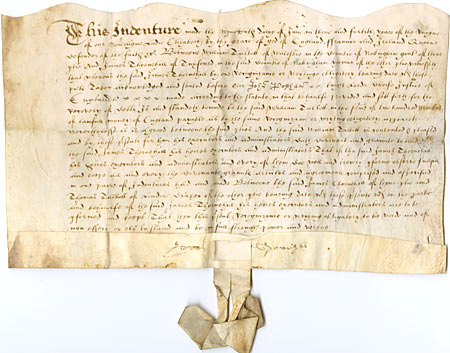Defeasance
A deed of defeasance was a deed drawn up at the same time as another document, which set out the conditions under which the second document would become null and void ('defeated').
Defeasances were often associated with recognizances of statute staple or statute merchant, but also exist in collaboration with mortgage deeds and deeds relating to complicated conveyances of land. They appear over a wide period of time, from the thirteenth century to the twentieth century.
They need to be understood in the context of the associated deeds or documents, but most defeasances include recitals explaining their purpose. It is important to remember that they only set out a possible final scenario. It was possible that the conditions were not met, and the principal deed would remain in force for some considerable time.
Purpose
Setting out the conditions under which another document would become null and void.
Features of a defeasance
- 13th-20th centuries
- written on parchment
- usually written in Latin until c.16th century
- indenture (wavy top edge)
- seal
Example
Ne D 4340 - Defeasance from William Talbot to James Thornhill of a recognizance of a statute staple; 19 Jun. 1599

View this deed
This defeasance relates to the statute staple transcribed on the page relating to recognizances.
Transcription
[line 1] This Indenture made the nynetenth daye of June in thone and fortith yeare of the Raigne
[line 2] Of our Sou[er]aigne Ladie Elizabeth by the grace of god of England, Fraunce and Ireland Queene
[line 3] defender of the faith &c. Betweene William Talbott of Walesbie in the Countie of Nottingham gent of thone
[line 4] p[ar]tie And James Thornehill of Tuxfourd in the said Countie of Nottingham yeoman of the other p[ar]tie Witnesseth
[line 5] that whereas the said James Thornehill by one Recognizance or Weytinge obligatory bearing date w[i]th these
[line 6] p[rese]nt[es] Taken acknowledged and sealed before Sir John Popham knight Lorde Cheife Justice of
[line 7] Englande made according to the statute in that behaulfe provided and sett forth for the
[line 8] Recovery of debt[es], Is and standeth bownde to the said William Talbott in the som[m]e of two hundred merkes
[line 9] of lawfull money of England payable as by the same Recognizance or weyting obligator appeareth
[line 10] Neverthelesse it is agreed betweene the said p[ar]toies And the said William Talbott is contented & pleased
[line 11] And by these p[re]sent[es] for him his executors and administrators doth covenant and graunte to and w[i]th
[line 12] The said James Thornehill his heires executors and administrators That if the said James Thornehill
[line 13] his heires executors and administrators and every of them doe well and trewly p[er]forme observe fullfill
[line 14] and keepe all and every the Covenant[es] graunt[es] articles and agreement[es] comprised and especified
[line 15] in one paire of Indentures had and made Betweene the said James Thornehill of thone p[ar]tie and
[line 16] Thomas Talbott of London draper of the other p[ar]tie bearing date w[i]th these p[re]sent[es] w[hi]ch on the parte
[line 17] and behaulfe of the said James Thornehill his heires executors and administrators are to be
[line 18] p[er]formed and keept That then this p[re]sent Recognizance or weyting obligatory to be voide and of
[line 19] non effect or els to stand and be in full strength power and vertue
So, having read the statute staple and the defeasance, we still have to locate the other indenture of even date which explains the covenants that James Thornhill was agreeing to abide by. Luckily, it was kept in the same deed bundle and is now numbered Ne D 4338. The deed is an enrolled bargain and sale from James Thornhill to Thomas Talbott, of a messuage and lands in Walesby and Willoughby, Nottinghamshire. The deed includes the usual sorts of covenants which were included in deeds of sale, such as a warranty clause confirming that Thornhill had a good title to the land, and a clause for quiet possession of the land by Talbott. So, as long as Thornhill left Talbott undisturbed in the property, and it was not found to be an unlawful conveyance, the defeasance would defeat the statute staple and the 200 marks would not have to be paid.
Next page: Deeds table